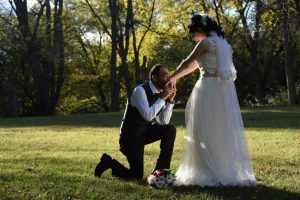By Chapel Fowler
Sam Gee sat on the top floor of New West on Monday night, typing furiously as he scoured Google for a punchline.
At the podium in front of him, Luke De Mott was halfway down a rabbit hole already. During the formal debate portion of this Dialectic and Philanthropic Societies (DiPhi) meeting, designated senators met to argue in favor of or against that night’s topic at hand: were J.K. Rowling’s recent retroactive changes to her “Harry Potter” series illegitimate?
Once the floor was open, De Mott launched into a sarcastic rant. The senior Phi senator started off with a friendly jab, telling his rival Di senators they “don’t control fiction.” There’s no objective truth to imaginary worlds, he said, and no incorrect interpretations of art. It’s all up to the reader.
Gee’s typing stopped. He’d found his counterpoint. The sophomore Di senator shot his hand up from his third-row desk. Quoting the famous line from “Hamlet,” he said: “Something is rotten in the state of Denmark.”
“So,” Gee said, “is it possible that Hamlet is set on Mars?”
“Well,” De Mott said, “Maybe Mars has a Denmark.”
And with that, the chambers of UNC’s oldest student organization erupted in laughter.
History of the society
For 224 years, DiPhi has offered students a platform for robust debate with competition and friendship on the side. In 2019, the society is a bit more modern than in decades prior, with a well-designed website, active social media pages and senators reading speeches off laptops. But the rich history, many procedures and the fundamental goals of DiPhi remain the same.
“I think a bunch of students having a bunch of opinions and wanting to share them on their own accord is a really cool thing,” said Katrina Smith, a senior and joint senate president this semester. “I don’t think there are many spaces like that, where students come here for fun to do this.”
DiPhi, established in 1795, has been involved in all kinds of UNC history. Most notably, the societies’ use of diploma ribbons — light blue for Dis, white for Phis — helped inspire UNC’s now-famous school colors. The societies, which merged into a joint senate in 1959, also operated as the student government for over a century. DiPhi helped shape the UNC Honor System and the Yackety Yack yearbook, among other campus institutions.
But if you take a trip to Room 310 in New West, the history of DiPhi and its participating students truly come to life.
The space itself is regal, with cream-colored walls, blue trim and four massive golden chandeliers. All of the furniture is wooden, save for a chair made of literal cow hide and cow horns. Portraits of famous DiPhi alumni and honorary members hang wherever they can fit.
“It’s so cool,” said Peyton Furtado, a junior and Phi’s president. “To just study in some of these chambers and realize that people like Thomas Wolfe, Joseph Caldwell, James K. Polk have all been in these rooms and have been doing basically the same thing we’re doing.”
The debate comes alive
Each meeting begins at 7:30 p.m. On this night, Jack Watson took the podium after a roll call. As the critic, he alerts speakers when their time is up by ringing a silver bell and critiques his fellow senators’ performances after debate ends.
DiPhi debates start with a resolution, or an opinionated statement. Senators then argue in favor of or against it. This particular night’s resolution revolved around Rowling, who recently tried to add extra information to the “Harry Potter” canon to mixed results. Watson smirked as he introduced the topic.
“First, she said Dumbledore was gay, and I said nothing, because sexuality is a spectrum and I can buy that,” he said. “Then, she said, ‘I never said Hermione wasn’t black,’ and I said, ‘That’s kind of a weird way to say that, but OK.’ And then, she said that wizards used to poop on the floor, and I could say nothing, because it was my fault for retweeting her for so long.”
The debate took off from there. Senators against Rowling’s decision offered strong arguments: that art can’t retroactively be changed, that Rowling should create new diverse art instead.
Those arguing for Rowling advocated just as intensely. One interesting point brought up the question: Whether publication is the true cut-off point for a book, or is it just an artificial boundary placed on the author? All through the debate, senators snapped their fingers when they agreed with something, and they hissed loudly when they didn’t.
Among the structure and carefully curated arguments, though, there’s plenty of humor. Gee created his own obscene revision and joked that Dobby the elf had “a 10-inch rod.” Sophomore Mo Van de Sompel decided to push back on the idea that all interpretations of art are valid with an off-the-wall hypothetical.
“I choose to believe that The Very Hungry Caterpillar is not a white supremacist,” Van de Sompel said. “But if the author, Eric Carle, comes out tomorrow and says the caterpillar is a neo-Nazi, do I have to accept that?”
The fun continued into DiPhi’s other main staple — PPMAs, or papers, petitions, memorials and addresses. During this “signature free speech forum,” anyone can rant on whatever they want for up to five minutes. On this night, many chose comedy.
Senior Kristen Roehrig recounted the panic attack she had in a Washington, D.C., bathroom (“This will be a good story for an interview someday”). Watson, the critic, talked about how he discovered his inverted nipple (“Lefty goes in; righty goes out”). One senator told the story of a piece of cheese thrown so perfectly it landed inside someone’s pocket; another broke down the phenomenon of orange plastic Garfield telephones washing up on France’s beaches.
“We have lightheartedness in the serious,” sophomore Christina Barta said. “We also have seriousness in the lighthearted.”
The Rowling debate wasn’t exactly political. But political debates are frequent. Last month, six senators presented their argument for the best 2020 presidential candidate. In February, DiPhi hosted the second UNC student body president debate. Other topics that were tackled this semester included the two-child policy, how familiar Americans should be with the Bible and if wars have been beneficial to mankind.
There’s usually a quota — one science debate, one policy debate, one literary debate and so on — but Smith said DiPhi’s been more flexible this semester. Thanks to a wide array of majors and interests in the society, the balance between serious debates and more lighthearted ones “just ends up happening.”
Monday night’s meeting didn’t adjourn until past midnight, but, to no surprise, another DiPhi tradition held true. Senators made the short walk from campus to Linda’s Bar & Grill on Franklin Street for baskets of cheese fries.
They’ll be back at it again next week with a fresh topic: whether or not homeschooling should be abolished. They’ll be debating, like they have been for 225 years.
In the words of the DiPhi Facebook page: “The conversations don’t ever have to stop.”
Edited by Caroline Metzler and Nick Thompson


